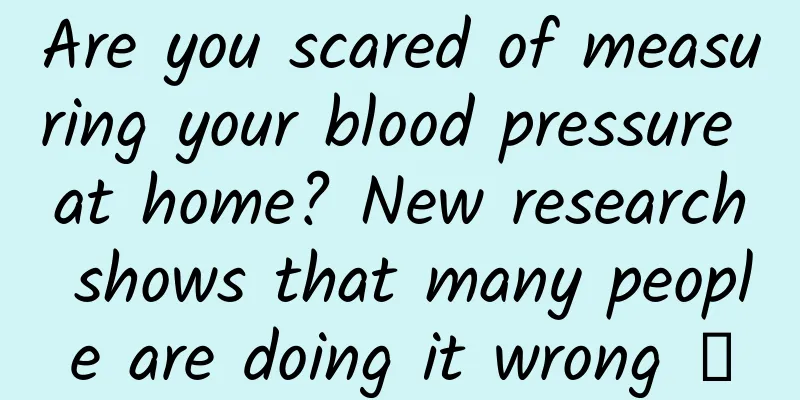Are you scared of measuring your blood pressure at home? New research shows that many people are doing it wrong →

|
Compiled by: Gong Zixin now More and more families will have their own blood pressure monitor But many people found Some people worry that their blood pressure is "out of control" because it does not match the values measured in the hospital. actually Often the reason why blood pressure is inaccurate is Closely related to the details of measuring blood pressure A commonly used method of arm placement for blood pressure screening can significantly overestimate test results and may lead to a misdiagnosis of high blood pressure, concludes a study led by researchers at Johns Hopkins University School of Medicine. In the study, published Oct. 7 in JAMA Internal Medicine, researchers examined the effects of three different arm positions: one arm supported on a table, one arm supported on the knee, and one arm hanging unsupported at the side. The researchers found that the thigh-supported position overestimated systolic blood pressure (the top number in a blood pressure reading) by nearly 4 mmHg, while the arm hanging unsupported at the side overestimated systolic blood pressure by nearly 7 mmHg. The findings confirm that arm position has a "huge impact" on accurate blood pressure measurements, says senior author Tammy Brady, M.D., associate director for clinical research in pediatrics and deputy director of the Center for Epidemiology and Clinical Research at the Johns Hopkins University School of Medicine. They underscore the importance of following clinical guidelines when measuring blood pressure -- to have firm support on a table or other surface. High blood pressure is diagnosed when the force of blood flowing through blood vessels is measured to be higher than what is generally considered normal. If untreated, high blood pressure increases the risk of stroke, heart attack, and other serious cardiovascular diseases. Because high blood pressure can cause mild or no symptoms, early and frequent screening during routine checkups is considered the cornerstone of high blood pressure management. In most cases, lifestyle changes such as weight loss, healthy eating, and exercise, as well as any type of medication, can control blood pressure. The American Heart Association's most recent clinical practice guidelines emphasize several key steps to accurately measuring blood pressure -- including proper cuff size, back support, feet flat on the floor with legs uncrossed, and proper arm positioning, with the middle position of the adjustable blood pressure cuff at mid-heart level with the arm supported on a table. Despite these recommendations, researchers say that blood pressure measurements are often taken while patients sit on the examination table without any or inadequate arm support. In some cases, clinicians hold the arm, or patients place their arm on their knees. For the study, researchers recruited 133 adult participants ranging in age from 18 to 80 years old, who were randomized into six groups that differed in the order of arm sitting. Measurements were taken during a single visit between 9 a.m. and 6 p.m. Before taking a blood pressure measurement, all participants first emptied their bladders and then walked for 2 minutes to mimic a typical clinical scenario of walking into a clinic or office before screening. They then rested for 5 minutes while sitting with their backs and feet supported. Each person wore an upper arm blood pressure cuff of a size selected based on upper arm size and took three sets of three measurements with a digital blood pressure monitor at 30-second intervals. After completing each set of 3 measurements, the cuff was removed and participants walked for 2 minutes and rested for 5 minutes. During the same visit, they performed a fourth set of 3 measurements with their arm supported on a table, which was used to account for changes in blood pressure readings. All measurements were performed in a quiet, private space, and participants were asked not to talk to research staff or use their phones during the screening period. The researchers found that the arm position often used in clinical practice -- with the arm resting on the knee or at the side without support -- yielded significantly higher blood pressure measurements than those obtained with the arm supported on a table, which is the standard, recommended arm position. With the arm on the knee, systolic blood pressure (the top number of the reading, or the force of blood flowing through the heart as it pumps) was overestimated by 3.9 mmHg, and diastolic blood pressure (the pressure in the arteries when the heart is resting between beats) was overestimated by 4.0 mmHg. With the arm unsupported at the side, systolic blood pressure was overestimated by 6.5 mmHg and diastolic blood pressure was overestimated by 4.4 mmHg. "If blood pressure is consistently measured with the unsupported arm, it can overestimate blood pressure by 6.5 mmHg, which could be the potential difference between a systolic pressure of 123 and 130, or between 133 and 140, which might be considered stage 2 hypertension," says study author Sherry Liu, coordinator of epidemiology research in the Welch Center for Prevention, Epidemiology, and Clinical Research in the Department of Epidemiology at the Johns Hopkins Bloomberg School of Public Health. The researchers caution that their findings may apply only to screening with electronic blood pressure devices and not to readings from other blood pressure devices. Key Points How to measure blood pressure accurately at home? The US blood pressure measurement statement gives some suggestions: 01Strongly promote electronic blood pressure monitor: An electronic blood pressure monitor is preferred because it has an electronic pressure sensor that reduces human error, and a certified upper arm cuff blood pressure monitor should be used, which is accurate and reliable. 02The cuff size should be correct: The most common reason for inaccurate blood pressure measurement is an inappropriate cuff. The cuff balloon length should be 75% to 100% of the upper arm circumference, and the cuff balloon width should be 37% to 50% of the upper arm circumference (length-to-width ratio 2:1). For those who are too obese, an arm cuff is not enough and a leg cuff can be used. 03 The correct posture for measuring blood pressure: Sit still for at least 5 minutes and urinate before the test. Do not exercise, drink coffee or smoke 30 minutes before the test. When measuring blood pressure, it is best to have the cuff in direct contact with the upper arm. When lying on your back, you need to raise your arm appropriately. When sitting, sit in a chair with a backrest and relax your body. Crossing your legs during measurement will increase systolic and diastolic blood pressure, so keep your feet flat. |
<<: A man's eyes were burned while clearing the toilet. Be careful when using pipe cleaners!
>>: More than 1,700 ancient viruses found in glaciers. Are they a threat to humans?
Recommend
How much does it cost to develop a vegetable delivery mini program? How much does it cost to develop a store mini program?
Food is the primary need of the people. Food is v...
Samsung Note Edge hands-on experience: the side screen is the highlight
Samsung Galaxy Note Edge is undoubtedly the highl...
Has human evolution stopped?
Image source: pixabay Since human ancestors left ...
How to play CPA advertising project? Use ad networks to earn revenue!
CPA is a common advertising promotion method at p...
A mind map will help you understand the tricks of operating the points mall!
Points Mall Operation System (Mind Map of this Art...
The “protection period” of the new coronavirus antibodies is almost over. Do I need to get vaccinated again?
"As time goes by, the titer of new coronavir...
Let's spend a peaceful year together! Please check the safety guide for setting off fireworks and firecrackers
As the Spring Festival approaches, many places ac...
Why are vaccines given in the arm instead of the buttocks? How many "vaccine marks" do you have on your arm?
Expert in this article: Li Xue, Peking Union Medi...
50 proposal skills that planners must have in 2020
Introduction丨Proposal is also a technical job A g...
In the tenth year, what choice did Gudong make?
[51CTO.com original article] The launch of the fi...
iOS channel first release rules and contact list
91 Assistant 1. First Release Form During the ini...
Fish's memory not only exceeds 7 seconds, some fish may also have prehistoric memory
Produced by: Science Popularization China Produce...
When it comes to community operations, 80% of people have positioned themselves incorrectly!
80% of the people who create communities do so fo...
Gu Junshan's resume: How to obtain accurate traffic for Chongqing website optimization?
In recent years, website promotion has become mor...









